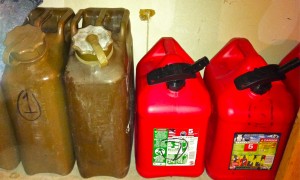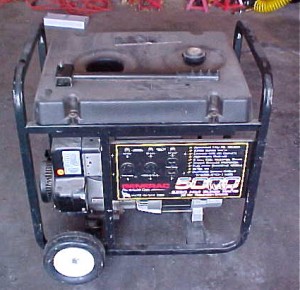 Sarah and I are having a quiet Christmas. The kids are celebrating with their mom (we alternate holidays) and Sarah’s parents are travelling, so it’s just the two of us. Since it’s the first Christmas with just the two of us, we decided to start some new family traditions. One was, instead of buying a pre-cut tree (that has to be hauled away afterward – they’re not even good for composting), or an artificial tree (that has to be stored using valuable storage space); we chose a live Christmas tree. Our plan, after the holidays, is to transplant it into a whiskey barrel and set it in a good spot in the yard. Then each year we’ll get another tree and place them together. Until–this is the cool part–we finally get our homestead, then we’ll move all the trees there and plant them permanently so we’ll have our own family Christmas tree forest. We’ll still continue to add a new one each year, so we’ll have from the oldest (this year’s) to the newest, each representing a Christmas together. We got a Blue Spruce. It was my idea, I grew up in Colorado and the Blue Spruce is Colorado’s state tree, and Sarah happily supported my decision. The tree is about five foot tall, we decorated it simplistically — and it looks beautiful.
Sarah and I are having a quiet Christmas. The kids are celebrating with their mom (we alternate holidays) and Sarah’s parents are travelling, so it’s just the two of us. Since it’s the first Christmas with just the two of us, we decided to start some new family traditions. One was, instead of buying a pre-cut tree (that has to be hauled away afterward – they’re not even good for composting), or an artificial tree (that has to be stored using valuable storage space); we chose a live Christmas tree. Our plan, after the holidays, is to transplant it into a whiskey barrel and set it in a good spot in the yard. Then each year we’ll get another tree and place them together. Until–this is the cool part–we finally get our homestead, then we’ll move all the trees there and plant them permanently so we’ll have our own family Christmas tree forest. We’ll still continue to add a new one each year, so we’ll have from the oldest (this year’s) to the newest, each representing a Christmas together. We got a Blue Spruce. It was my idea, I grew up in Colorado and the Blue Spruce is Colorado’s state tree, and Sarah happily supported my decision. The tree is about five foot tall, we decorated it simplistically — and it looks beautiful.
I had a couple of minor opportunities to use our preps this last week. No big deal, but it did make me realized how nice and safe it feels to be prepared. The first one, we were up in Anacortes and had just finished watching Sarah’s mom, Libby, in a local production of Over the River and Through The Woods (she was great!). When we finally got out to the parking lot, most of the cars were gone, and an older man timidly approached me and asked if I had jumper cables because they had left the lights on in their van and it wouldn’t start. Without hesitation I grabbed the cables and, with Sarah’s help, quickly got him going again. Why is this a prepper topic? Because when we added a BOB* to Sarah’s car we also added some emergency car items, including the cables. We purchased heavier gauge wires, figuring if we needed them we wanted to be sure they’d work. Interesting to note, we were the only car around that had jumper cables (he had been asking around for a while and was almost ready to call a tow truck).
The second time was when someone (not naming names, but it wasn’t Sarah or I) let the Jeep run out of gas (coincidentally and luckily it was in the garage). We couldn’t figure out why it wouldn’t start, until I checked the gas gauge… Normally I don’t let any of our  vehicles get below a quarter tank (most of the time I fill up at about half tank), so I was surprised it had gotten so low. Fortunately we had plenty of gasoline right there available. I grabbed a 5-gallon can full of gasoline and the super siphon (those things are great, if you store gas you need one) and about three minutes later the Jeep fired right up. Again nothing we couldn’t have overcome with a trip to the gas station, but it was nice to be prepared.
vehicles get below a quarter tank (most of the time I fill up at about half tank), so I was surprised it had gotten so low. Fortunately we had plenty of gasoline right there available. I grabbed a 5-gallon can full of gasoline and the super siphon (those things are great, if you store gas you need one) and about three minutes later the Jeep fired right up. Again nothing we couldn’t have overcome with a trip to the gas station, but it was nice to be prepared.
What did you do?
(Monday: The Family You Choose)
*For a complete list of abbreviations/acronyms, and other information, open the above ‘Check Here…’ page tab.



